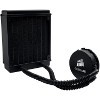- Qualcomm Launches Snapdragon 4 Gen 2 Mobile Platform
- AMD Launches Ryzen PRO 7000 Series Mobile & Desktop Platform
- Intel Launches Sleek Single-Slot Arc Pro A60 Workstation Graphics Card
- NVIDIA Announces Latest Ada Lovelace Additions: GeForce RTX 4060 Ti & RTX 4060
- Maxon Redshift With AMD Radeon GPU Rendering Support Now Available
Corsair H70 CPU Cooler Follow-up Tests

After we published our review of Corsair’s H70 CPU cooler a couple of weeks ago, we couldn’t shake the nagging feeling that some additional testing needed to be done with different airflow configurations. We succumbed, and have the results here. Will using a config opposite to Corsair’s recommendation affect the temps? Read on.
Page 1 – Introduction
Over the years, I have had the chance to test nearly every form of available cooling available on the retail market. The products have come in all shapes and sizes and I have even had the chance to test some of more elaborate coolers like CoolIT’s Freezone and the Cooler Master’s V10. It has been quite an adventure to say the least, and the road did take many unexpected turns.
Heat pipe technology has also made major strides during the last five years as well. Companies such as Noctua and Thermalright put all their eggs in that basket and brought us some of the best air cooling devices conjured up by their R&D gurus.
Nowadays it is almost unheard of for any air cooling device to not contain some form of the venerable heat pipe and no one can deny that is a very good thing for us all. I have managed some stellar over clocks with these beasts of burden over the years and I can fondly look back at the fun I had pushing my hardware to the limits (and then some) in pursuit of that ever elusive record benchmarking score.
No trip down my memory lane would be complete without also looking back at the many custom water cooling systems I built. From the first generic ¼” ID (inside diameter) assortment of blocks, tubing and pumps to the baddest ½” ID high-end setups, I had a lot of fun designing and putting together some highly effective cooling loops. From Danger Den to Swiftech to Eheim and more, I’ve had some hardcore fun. I can fondly remember pushing my little AMD Opteron 165 to 3.25GHz back when it was nearly impossible to surpass the magical 3GHz barrier. Those were good times to be an enthusiast for sure.

Initial all-in-one prebuilt water cooling systems were nothing more than toys back then. No matter how much you spent on your Zalman or Thermaltake stuff, my custom setup would tromp your results. Even worse were the die-hards who would take pleasure in calling out such users confidently stating that there was no such thing as prebuilt in the world of water cooling. You had to build it yourself or go home, it was that simple. Sad to say, they were right.
That was then, and this is now. Over the last 2 years, two companies have emerged to design and build real and very effective pre-built water cooling systems. First was CoolIT Systems with its Freezone TEC coolers which long ago proved to become one of the first to tame the almighty Intel Core 2 Quad processor. The company’s follow-up models of the PURE, Domino and ECO also proved that there truly was an alternative to air cooling.
A short time later, Corsair threw its hat into the ring and showed us time and time again that all-in-one water cooling kits are more than capable of hanging with the big dogs. The original H50 came onto the scene with a loud and thundering roar. It was highly effective and was well priced to boot. There was the larger dual 120mm model that I was not able to test and it too showed us some real horsepower. With thermal wattage climbing ever higher, no one can afford to sit back on yesterday’s models. Being the best cooler last week is not always a good thing when there are more and more models released all the time.
The H70 was the natural evolution to the original H50. Sporting dual fans and a thick-bodied radiator, it graced our test bench a short two weeks ago proving once again that not only are these cooling solutions viable, they are pretty much the only possible way to do the job silently. My initial review speaks for itself and Corsair has rightly carried the torch forward for the all-in-one cooling world and it has done it in style, too.
The only thing left wanting from my original review was some further testing to see if there was any way to further enhance the cooling power. Today’s revisit is just that… a follow up on the original review.
Support our efforts! With ad revenue at an all-time low for written websites, we're relying more than ever on reader support to help us continue putting so much effort into this type of content. You can support us by becoming a Patron, or by using our Amazon shopping affiliate links listed through our articles. Thanks for your support!




